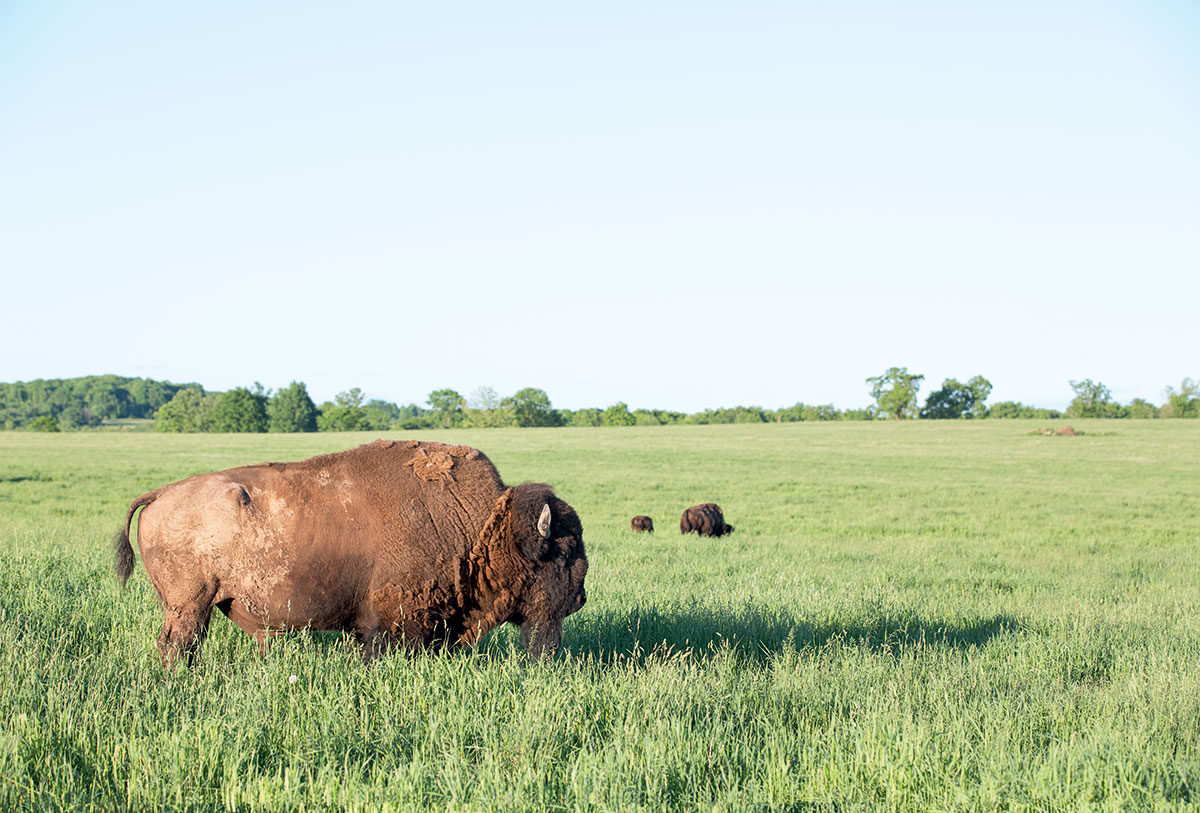Bison: At Home, On the Range
Recently declared our national mammal, bison are making a comeback – at grocery stores, restaurants, and, slowly but surely on America’s wide-open plains.
In 1994, when Mary and Lee Graese bought their first two bison, beef was what’s for dinner, as Robert Mitchum’s voice intoned on the omnipresent television ads. We’re talking a few years before those Texas cattle ranchers sued Oprah over her mad cow”“related comments and nearly a decade before Ted Turner launched Ted’s Montana Grill – giving many Americans their first taste of bison, in chili, over nachos, and formed into lean burgers topped with jalapeños or blue cheese.
Yet Lee Graese humbly waves off any notion that he possessed uncannily prescient business savvy. “Initially, this was going to be a hobby,” he says of the dusky brown bull, Billy, and tawny heifer calf, Sarah, that he and his wife purchased from Minnesota’s Blue Mounds State Park as its rangers thinned the herd. “But we realized, after learning a bit more about the meat, that there was potentially a huge market for it.”
Two decades later, the price of bison meat – high in protein, low in fat and cholesterol, and, if grass-fed, rich in omega-3s – has tripled, from $1.50 to more than $4.50 a pound. In the past five years alone, restaurant and super-market sales have increased by $100 million. “We’ve not been able to grow fast enough,” says Lee, CEO of NorthStar Bison. The Graeses’ company currently comprises a 700-head herd, grazing on a dozen properties throughout northwest Wisconsin, including a ranch in Rice Lake, where the family lives, and in east-central Minnesota. The domain totals some 1,800 acres.
Lee and Mary’s daughter Marielle Hewitt and son, Sean Graese, oversee day-to-day ranch and business management, respectively. And the orders keep pouring in for their grass-fed and -finished plains bison (the only breed in America). “In the first few months of 2016,” says Lee, “we had requests for five times the amount of product that we could possibly pull together in an entire year.”
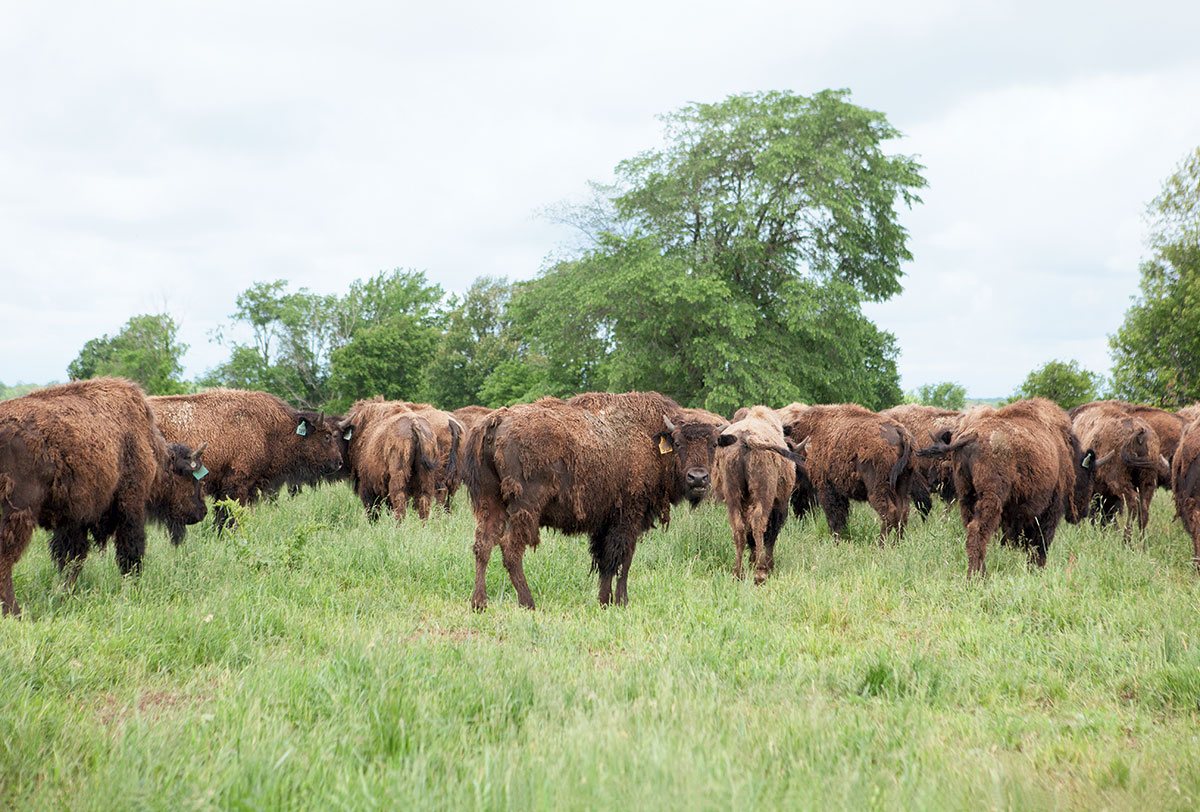
During the 1600s, bison were so prevalent in the territory that became Wisconsin that French explorer Pierre-Esprit Radisson reportedly called the region’s Eastern Dakota tribe “The Nation of Beef.” Historical accounts from the mid-1700s refer to bison crossing the Wisconsin River in such prodigious numbers that settlers had to sit and wait for the animals to clear before canoes could pass safely.
Then, in the 1870s, President Ulysses S. Grant and his advisers decided the best way to force Native Americans to assimilate would be to eliminate their food supply. The federal government paid hunters $80 a day (the equivalent of $1,400 now), and a single outing sometimes yielded 2,000 carcasses. The railroad’s western expansion also took a serious toll. By 1885, the number of bison in this country had shrunk from upwards of 30 million to less than 350. The latest stats put the United States total near 300,000 – much improved, but a far cry from our nation’s once-thriving population.
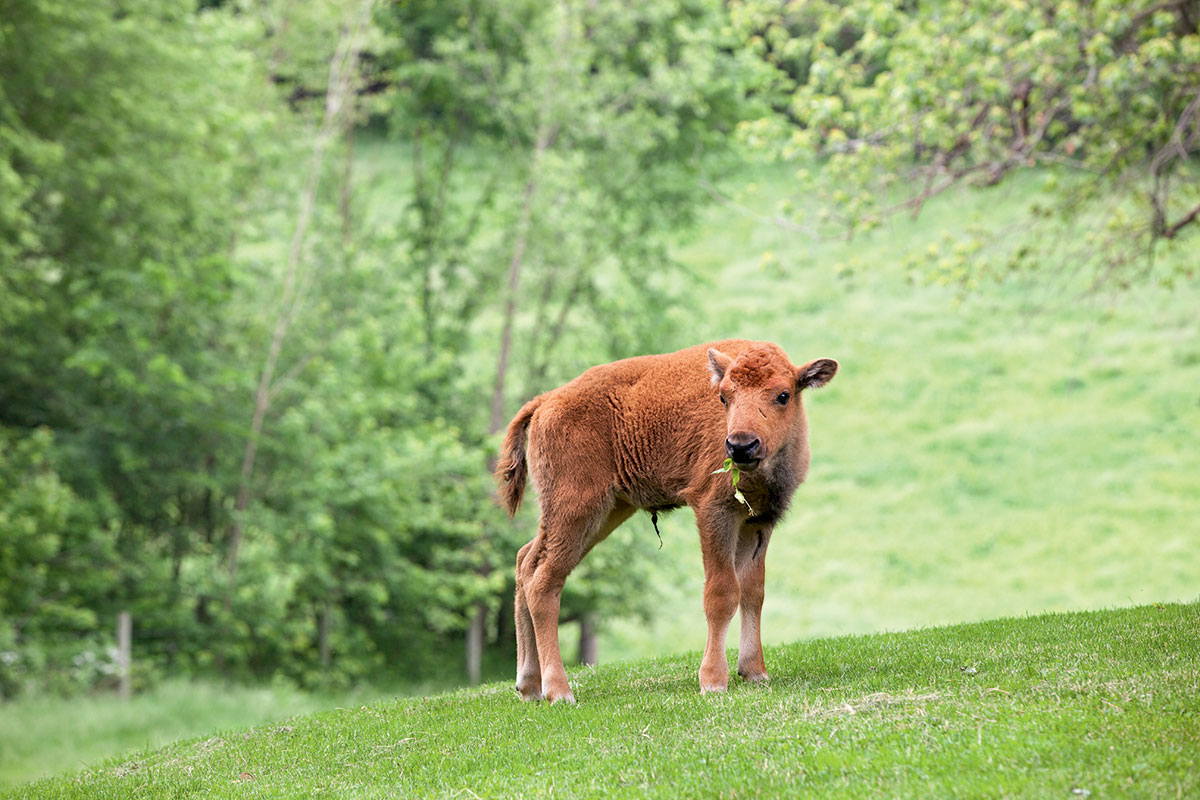
The Graeses have adopted a measured approach to expanding their herd. Due to the small pool of available bulls, in-breeding remains a long-term concern. Plus, bison don’t take to artificial insemination like cattle. “This is not an animal you can accelerate,” explains Marielle, 26. “And for us, it’s a marathon, not a sprint.”
Though the vast majority of bison farmed in America eat (or are at least finished on) grain, NorthStar’s subsist solely on grass. Such pasture-raised purity means the Graeses’ bison reach market weight 6 to 14 months later than their grain-fed brethren – an investment the company doesn’t recoup at the consumer level (see “Grass- vs. Grain-Fed,” below).
“Our philosophy is to work with nature, not against it,” says Sean, 29. “We let bison be bison.” Marielle reserves two acres of land per head, rotating the herd every few days. Beyond that, the animals require little intervention. Electrified fences discourage straying. There are no barns. NorthStar doesn’t brand, dehorn, inject growth hormones (per federal law), or administer antibiotics (against National Bison Association rules). Explains Marielle, “Bison do a very, very good job of taking care of themselves.”
The ranch also has no need for farm equipment, herbicides, or chemical fertilizers, instead relying on the animals to redistribute seed and fertilize the land. “We look at things from the ground down, not the ground up,” says Marielle.
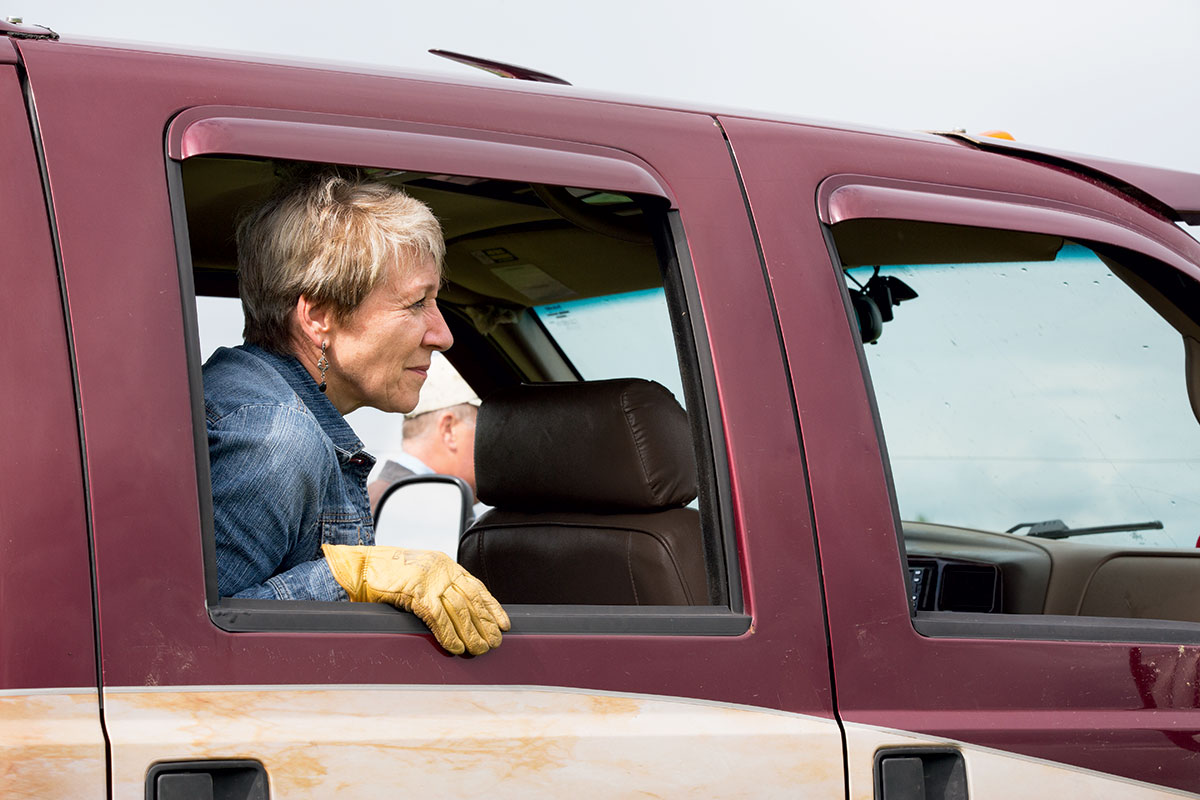
It’s harder to romanticize the end game. But at least the Graeses avoid the typical conclusion, which involves trucking adult bison hundreds of miles to the nearest slaughterhouse, where they’re funneled into squeeze chutes to be killed. The stressful experience toughens the meat, most ranchers agree, because the adrenaline rush releases cortisol.
“Our entire goal for 30 months is to raise these animals humanely to make the best-tasting, most tender meat,” says Sean. “At the last moment, to throw them into a chute would violate everything we’ve done up to that point.” Instead, he and Lee conduct field kills in a paddock near the NorthStar processing plant (see “The Humane Harvest,” below). “I’ve not found many operations raising 100-percent grass-fed bison and doing field kills,” says Sean Lenihan, founder of the Honest Bison, a California retailer that sources meat from NorthStar. “The perception is the opposite. Most people think it’s all like this. You won’t see lots of pictures on the internet of the hundreds of thousands of bison that go through feedlots.” (In addition to wholesale clients like the Honest Bison, NorthStar sells direct to consumers via northstarbison.com.)
Lee happily shares his experience with regional dairymen and corn farmers considering a career switch. “That may not seem wise from a competitive standpoint,” says Sean, who’s poised to take over as CEO when his father retires in a few years. “But we don’t see things that way.” His dad agrees: “These animals cannot reproduce fast enough to keep up with demand. Even five or ten years out, we’re still going to be behind the curve on supply,” Lee explains. “Bison is a small industry. But the limit? The sky’s the limit. Or maybe the moon and the stars.”
[mf_image_grid_item src=”https://modernfarmer.com/wp-content/uploads/2016/09/bison-marielle.jpg” alt=”marielle hewitt” title=””]Mary and Lee’s daughter Marielle Hewitt oversees pasture management.[/mf_image_grid_item]
[mf_image_grid_item src=”https://modernfarmer.com/wp-content/uploads/2016/09/bison-sean-graese.jpg” alt=”sean graese” title=””]Sean Graese will take over as CEO of NorthStar Bison after his father retires in a few years. [/mf_image_grid_item]
[mf_image_grid_item src=”https://modernfarmer.com/wp-content/uploads/2016/09/bison-border-collie.jpg” alt=”border collie” title=””]Border collie Stitch accompanies the beasts when it’s time to rotate to a new pasture.[/mf_image_grid_item]
[mf_image_grid_item src=”https://modernfarmer.com/wp-content/uploads/2016/09/bison-graze-greens.jpg” alt=”” title=””]The ranch’s plains bison graze on Kentucky bluegrass, clover, dandelions, and other greens.[/mf_image_grid_item]
[mf_image_grid_item src=”https://modernfarmer.com/wp-content/uploads/2016/09/bison-processing.jpg” alt=”bison processing” title=””]NorthStar operates its own processing plant, located on the Conrath, WI, ranch where the animals spend their final days. [/mf_image_grid_item]
[mf_image_grid_item src=”https://modernfarmer.com/wp-content/uploads/2016/09/bison-filet-1.jpg” alt=”sean graese” title=””]As with beef, bison’s highest-quality cut is filet mignon. This six-ounce portion retails for about $20. [/mf_image_grid_item]
The Humane Harvest

When bison reach market weight, most producers herd their animals into semis and drive long hauls to the nearest slaughterhouse. Lee Graese, however, relies on a deer rifle, shooting his bison right in the field. “What you’re aiming for is the brain stem, which is about the size of your thumb,” he says. “When you hit that, it’s lights out.”
This might sound a little Wild West, but animal behaviorist Temple Grandin praises the method as ideal. “Field kills are the lowest-stress way to do it, if you do it right,” she says. “You have to kill with one shot – otherwise, the bison are in pain – and you have to get the carcass to a plant promptly.”
NorthStar bison are slaughtered on the Wisconsin ranch next to the firm’s processing plant. An inspector with the Wisconsin Bureau of Meat Safety is always present, per state law. “It doesn’t turn into a rodeo or a stampede,” explains Lee. “The other bison just look around a bit and keep grazing.”
Grass- vs. Grain-Fed
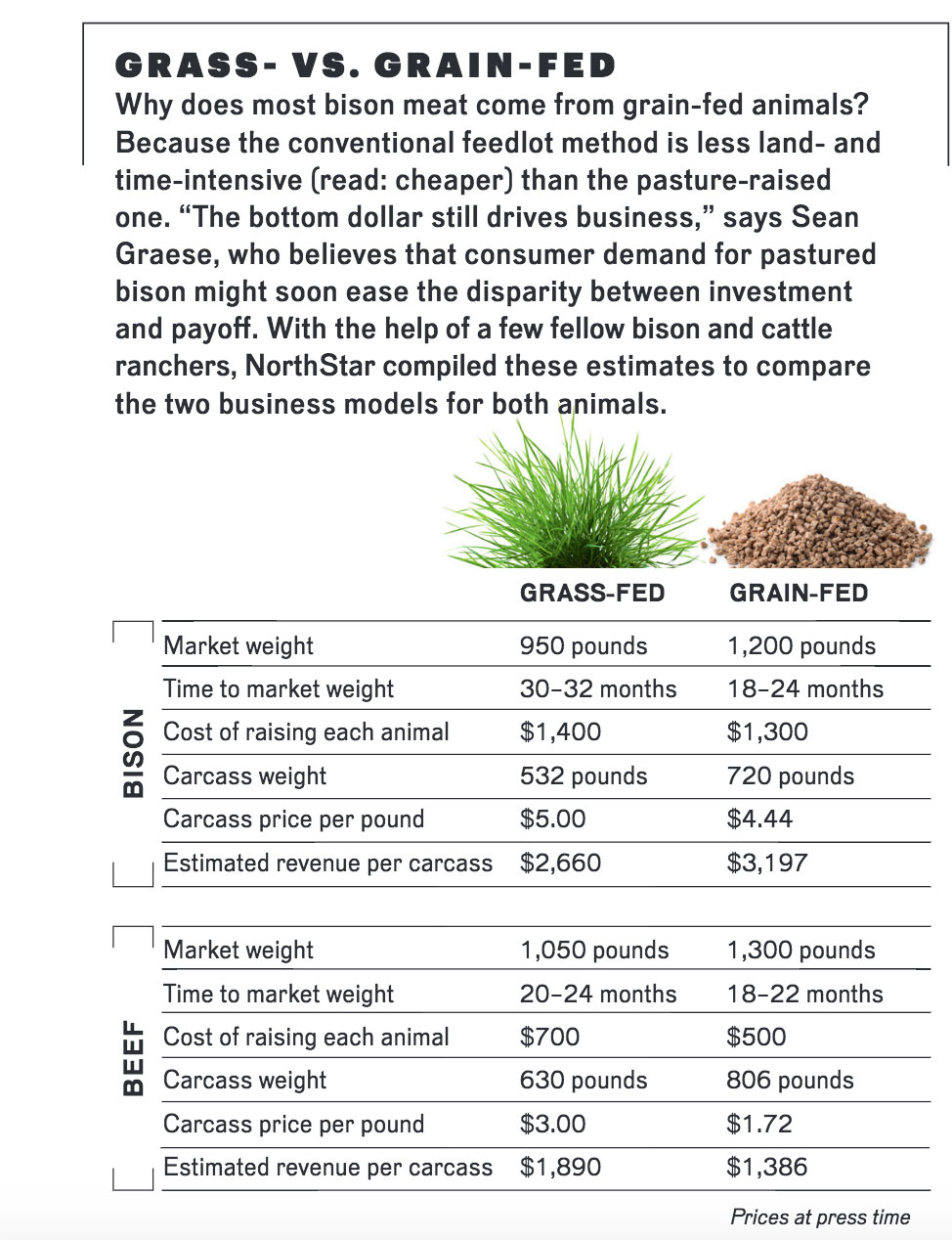
Check out all our stories from #bisonweek!
Follow us

This work is licensed under a Creative Commons Attribution-NoDerivatives 4.0 International License.
Want to republish a Modern Farmer story?
We are happy for Modern Farmer stories to be shared, and encourage you to republish our articles for your audience. When doing so, we ask that you follow these guidelines:
Please credit us and our writers
For the author byline, please use “Author Name, Modern Farmer.” At the top of our stories, if on the web, please include this text and link: “This story was originally published by Modern Farmer.”
Please make sure to include a link back to either our home page or the article URL.
At the bottom of the story, please include the following text:
“Modern Farmer is a nonprofit initiative dedicated to raising awareness and catalyzing action at the intersection of food, agriculture, and society. Read more at <link>Modern Farmer</link>.”
Use our widget
We’d like to be able to track our stories, so we ask that if you republish our content, you do so using our widget (located on the left hand side of the article). The HTML code has a built-in tracker that tells us the data and domain where the story was published, as well as view counts.
Check the image requirements
It’s your responsibility to confirm you're licensed to republish images in our articles. Some images, such as those from commercial providers, don't allow their images to be republished without permission or payment. Copyright terms are generally listed in the image caption and attribution. You are welcome to omit our images or substitute with your own. Charts and interactive graphics follow the same rules.
Don’t change too much. Or, ask us first.
Articles must be republished in their entirety. It’s okay to change references to time (“today” to “yesterday”) or location (“Iowa City, IA” to “here”). But please keep everything else the same.
If you feel strongly that a more material edit needs to be made, get in touch with us at [email protected]. We’re happy to discuss it with the original author, but we must have prior approval for changes before publication.
Special cases
Extracts. You may run the first few lines or paragraphs of the article and then say: “Read the full article at Modern Farmer” with a link back to the original article.
Quotes. You may quote authors provided you include a link back to the article URL.
Translations. These require writer approval. To inquire about translation of a Modern Farmer article, contact us at [email protected]
Signed consent / copyright release forms. These are not required, provided you are following these guidelines.
Print. Articles can be republished in print under these same rules, with the exception that you do not need to include the links.
Tag us
When sharing the story on social media, please tag us using the following: - Twitter (@ModFarm) - Facebook (@ModernFarmerMedia) - Instagram (@modfarm)
Use our content respectfully
Modern Farmer is a nonprofit and as such we share our content for free and in good faith in order to reach new audiences. Respectfully,
No selling ads against our stories. It’s okay to put our stories on pages with ads.
Don’t republish our material wholesale, or automatically; you need to select stories to be republished individually.
You have no rights to sell, license, syndicate, or otherwise represent yourself as the authorized owner of our material to any third parties. This means that you cannot actively publish or submit our work for syndication to third party platforms or apps like Apple News or Google News. We understand that publishers cannot fully control when certain third parties automatically summarize or crawl content from publishers’ own sites.
Keep in touch
We want to hear from you if you love Modern Farmer content, have a collaboration idea, or anything else to share. As a nonprofit outlet, we work in service of our community and are always open to comments, feedback, and ideas. Contact us at [email protected].by Abbie Fentress Swanson, Modern Farmer
September 12, 2016
Modern Farmer Weekly
Solutions Hub
Innovations, ideas and inspiration. Actionable solutions for a resilient food system.
ExploreExplore other topics
Share With Us
We want to hear from Modern Farmer readers who have thoughtful commentary, actionable solutions, or helpful ideas to share.
SubmitNecessary cookies are absolutely essential for the website to function properly. This category only includes cookies that ensures basic functionalities and security features of the website. These cookies do not store any personal information.
Any cookies that may not be particularly necessary for the website to function and are used specifically to collect user personal data via analytics, ads, other embedded contents are termed as non-necessary cookies.
